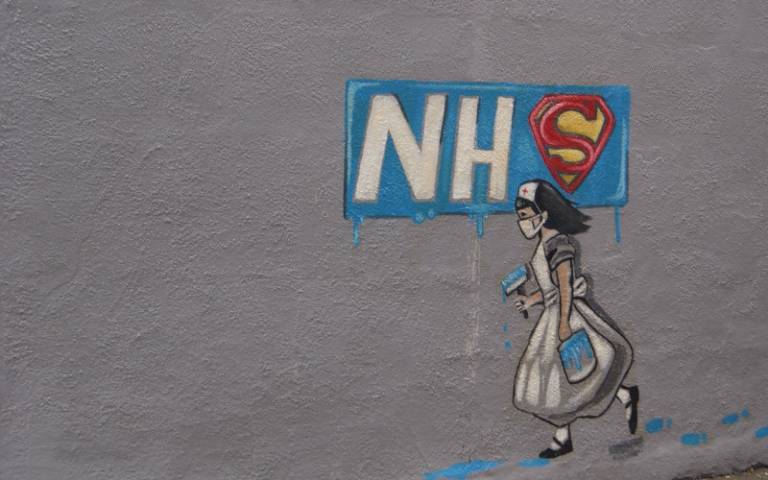Health inequalities worse in US than England
13 July 2020
People with low incomes have below-average health outcomes in middle age in both the US and England, but particularly so in the US, finds a new international study involving UCL.

Across every income group surveyed, people living in the US had worse health than their counterparts of similar incomes in England, finds the study published in JAMA Internal Medicine, led by the University of Michigan.
The differences were greatest among the lowest earners: middle-aged UK residents in the bottom 20% by income enjoyed better health across many measures than the poorest Americans of the same age group.
Low-income US residents were much more likely to have been diagnosed with high blood pressure, arthritis, diabetes, heart problems, stroke, chronic lung disease and mental health conditions than their low-income study participants in England.
Those in the US were also much more likely to have a high reading on three direct measurements taken by study staff, to test their blood pressure, blood sugar and a marker for inflammation called C-reactive protein.
Co-author Professor Andrew Steptoe (UCL Epidemiology & Health Care) said: “These are remarkable results, and confirm the value of comparisons between countries.”
“Differences in health care are part of the story, but even in England where care is free for everyone at the point of delivery, there are still marked differences in health related to income.”
The health gaps between high-income Americans and low-income Americans are particularly pronounced. In all self-reported measures, except history of cancer, the graphs of each health measure by income show the worst outcomes among the lowest-income Americans, sloping down to the best outcomes among those with the highest incomes.
Direct measurements of the three key health risk factors also tracked with income, though not as closely.
The researchers used data from two large, long-term studies conducted between 2008 and 2016, including interviews, income data and biomarkers from nearly 13,000 people in the US and 5,700 in England, aged 55 to 64. The disparities persisted even when the researchers adjusted for age, gender, race, household size, marital status, immigrant status and education level.
The study provides the most comprehensive comparison to date of health status between two countries according to income levels – but it paves the way for many more studies using the same approach.
More than 30 countries are now collecting data in a way that will allow this kind of apples-to-apples comparison in future, through a network of studies funded in part by the National Institute on Aging, part of the National Institutes of Health.
Lead author Dr HwaJung Choi (University of Michigan) said: “We may observe even greater income discrepancy in health – within and between countries -- for Americans, if we examine younger cohorts, as income inequality continues to increase in the US, and the health of subsequent cohorts seems even worse.”
The study also yields insights that may explain some of the extra burden of COVID-19 faced by low-income Americans.
Co-author Professor Kenneth Langa (University of Michigan) said: “Our analysis provides a comprehensive view of health disparities across many key outcomes, and shines a brighter light on the large differences in health and risk for the rich and poor in our country.”
“A number of the disparities that we found between low-income and high-income Americans – such as a higher risk of diabetes, hypertension, and higher levels of inflammation – are likely contributing to the much higher risk for COVID-related complications and death among the poor.”
The study used data from the Health and Retirement Study, based at the University of Michigan, and from the English Longitudinal Study of Ageing, or ELSA.
While past studies of English and American adults have looked at health differences and economic factors, they have more often focused on household wealth, which is different from income.
The study also shows how health problems affect other aspects of life, based on income. The lowest income Americans were much more likely to have problems carrying out daily activities like shopping, cooking and managing their own money than Americans with higher incomes, and English people of similar incomes.
The financial stress that comes with a low income can feed into health issues, including worse health-related behaviours such as smoking and unhealthy diets, say the authors. This can lay the groundwork for serious health problems earlier in life – such as strokes at younger ages, which were seen most often in the low-income Americans in the study.
But even high incomes didn’t protect Americans from having worse health. Even the top 10% by earnings – whose after-tax median incomes were $144,000 for Americans and $71,000 for the English – had significantly worse health on four of the 16 outcomes that were studied. Americans did not have better outcomes than English adults on any of the 16 health measures, even in the highest income group.
Links
- Research paper in JAMA Internal Medicine
- Professor Andrew Steptoe’s academic profile
- UCL Institute of Epidemiology & Health Care
- English Longitudinal Study of Ageing (ELSA)
Image
- NHS mural in Pontefract, West Yorkshire (Photo taken by Mtaylor848, Source: Wikimedia Commons)
Source
Media contact
Chris Lane
Tel: +44 (0)20 7679 9222
Email: chris.lane [at] ucl.ac.uk
 Close
Close

